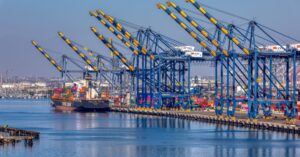Way back in 1979, FedEx — then known as Federal Express — ran a clever ad campaign highlighting its ability to handle expedited transportation (express IS in the name). A VIP (very important package) is handed off down the chain of command, with each person warning their subordinate, “If this package isn’t in Peoria by tomorrow morning, it’s your job.”
Expedited transportation, then and now, involves fast-as-humanly-possible delivery of high-priority items necessary to keep some kind of business process in motion. The difference today is that it’s much more in demand and much more prevalent of a service than it was 40-plus years ago. Growing global competition, supply chain disruption, and the “need it now” urgency of e-commerce have expanded the use of expedited delivery.
Situations often arise requiring the use of expedited freight services — and it’s not only for just-in-time scenarios like auto manufacturing. In fact, the global express delivery market was valued at $262.86 billion in 2020, and is projected to reach $484.38 billion by 2030, for a 6.4% CAGR.
In the current run-up to peak season, expedited freight is increasingly in demand as companies stage inventory in warehouses and fulfillment centers to prepare for year-end demand. Most may think of “air freight” when they hear “expedited,” but it’s often some combination of modes, especially air and ground, depending on the urgency of the shipment. For instance, expedited domestic shipping can mean a dedicated 53′ van, a box truck, or a cargo van, depending on the volume and weight and how far it needs to travel.
Still, the need for reliable expedited transportation is paramount, but securing it often presents challenges for shippers. To that point, we’ll discuss five tactics to help you ensure your fast delivery requirements are met.
Leverage Advanced Technology
When using any form of transportation, but especially expedited due to the urgency, knowing where your shipment is at any given time is critically important. If there are any snags or delays en route, you need to know as soon as possible. This is an area where modern technology provides a major assist.
Partnering with a third-party logistics (3PL) that provides real-time tracking is a baseline requirement, offering visibility into the status of critical deliveries. Comprehensive tracking includes status update emails and dashboards with access to signed import documents, notices of freight clearance, etc. For any expedited shipment, a 3PL should be ready with a contingency plan to address any potential delays or issues.
To optimize expedited freight spend, your 3PL should have a tool that can make informed decisions based on market dynamics. This technology can also optimize routes and enable quick adjustments, including rerouting if necessary. This ensures greater efficiency and reliability while enhancing the overall shipping experience.
Using AI and Predictive Analytics
Artificial intelligence is being used to improve communication between logistics providers and shippers. Large language models can be trained to determine if an incoming email is about shipment status, a pickup appointment or a quote request, and route it accordingly.
AI enables predictive analytics that can provide greater accuracy on forecasts of delays while optimizing routes in real time. It can analyze traffic patterns, weather conditions, and historical data to anticipate disruptions and improve delivery times. This makes for greater efficiency and reliability in meeting urgent delivery schedules.
Utilizing data analytics, companies can more accurately predict demand surges and adjust inventory levels accordingly in the event of spikes or falloffs. This keeps inventory right-sized and reduces the need to rely on last-minute expedited shipping.
Automating Documentation
Automated documentation helps streamline the paperwork process, reducing manual errors and delays. By digitizing various documents (bill of lading, invoice, customs forms), automation ensures accurate, timely information sharing among parties.
For cross-border shipments, this speeds up customs compliance checks and cuts down on transit point bottlenecks. Automated documentation for expedited transportation provides real-time visibility and traceability, helping you meet tight delivery schedules and maintain high service standards.
Partnering with a Reliable 3PL
Unless you’re in the logistics business yourself or have the resources to create an in-house transportation department, you’re going to need the help of an experienced 3PL that specializes in expedited transportation services. A top 3PL comes not only with industry knowledge and expertise but a solid network of carriers across modes and delivery types.
Here are some selection criteria to employ in vetting a 3PL partner for your expedited transportation needs:
- Track Record: How long has the company been in business? Are they profitable? How many clients do they have? Do they have experience in your particular industry or product line? What volume of annual shipments do they handle? Ask for referrals to other shippers they work with; if possible, go beyond the ones they recommend.
- Technology Adoption: What kind of technology platform do they have, on-premise or cloud-based? Do they have their own transportation management system (TMS) and communication tools? Do they provide customized reporting and dashboards, advanced shipment tracking, and notifications?
- Scalability: How flexible are they in terms of being able to scale up and down rapidly, as your business needs dictate? What kinds of resources are in place in terms of network capacity to handle volume spikes?
Building Long-Term Relationships
Like any business relationship, establishing a partnership with a 3PL that can stand the test of time brings several key advantages. It helps secure priority services, such as faster access to capacity during peak demand periods.
This type of partnership often results in more favorable pricing through negotiated carrier rates, reducing transportation costs over time. A long-term 3PL partner also becomes familiar with your business requirements and preferences. This facilitates streamlined operations and faster decision-making, anticipating your needs and providing proactive solutions.
Utilizing a Multi-Carrier Strategy
Your 3PL partner can help diversify your carrier portfolio, maintaining flexibility and service reliability. It allows you to expand your geographic reach more efficiently while mitigating the risk of disruptive events such as strikes or a capacity crunch, providing service continuity.
Tapping into a larger carrier base lets you compare and select the best services and rates based on specific routes or schedules. The only downside is losing volume discounts earned through a single-carrier approach, although this can be offset through effective pricing management and competitive bidding.
Optimized Routing and Scheduling
Route optimization helps reduce transit times and while avoiding congestion, increasing the percentage of on-time deliveries. By analyzing the most efficient route for each shipment, you can avoid high-traffic areas, road closures, and other causes of delays.
This type of strategic planning reduces fuel consumption and lowers costs. Advanced software tools enable dynamic route planning based on real-time data, enabling you to adjust routes as needed. The fastest and safest routes are always chosen, cutting down on delays and improving service reliability.
Leveraging Just-In-Time Inventory Management
A just-in-time inventory (JIT) approach helps build up supply chain resilience and reduce risk. And expedited shipping is a key tactic that ensures the timely flow of materials needed to match production with demand in a JIT scenario.
Expedited transportation within the context of JIT is designed to quickly deliver goods as needed, keeping inventory lean and reducing carrying costs. It’s crucial for maintaining a seamless, efficient production process.
By using expedited transportation for JIT, lead times are reduced, enabling companies to swiftly respond to demand shifts. Even though expedited shipping comes at a premium compared to standard shipping, the added expense is cheaper than the thousands of dollars lost if a production line shuts down due to a lack of parts.
Effective Communication and Customer Service
Clear communication is a must when planning for expedited shipping with a logistics provider. There are many important details to cover, from order volumes, shipment destinations, carrier agreements, budgeting, cost, and transportation mode. Every step of the way, your 3PL should lay out what to expect and work in a collaborative, consultative manner to help you map out an effective strategy.
On the customer end, take a proactive communication approach in order to manage and set realistic expectations for expedited deliveries. This reduces the likelihood of dissatisfaction from any unforeseen delays. Establishing a customer feedback loop helps you continuously improve the shipping experience. By collecting and analyzing feedback, you can identify areas for improvement, tailor services, and ensure high satisfaction levels.
Maximizing the Power of Expedited Transportation
Expedited transportation is a key weapon in the arsenal for companies that need to react quickly to changing market conditions, demand patterns, or supply shortages — just about anyone, really. But it is a higher expense than standard shipping, so it needs to be managed carefully.
Investing in technology, finding a reliable logistics partner, optimizing routing and scheduling, taking a JIT inventory approach, and being proactive in customer communications will help you take full advantage of the benefits of expedited transportation.
COGISTICS Transportation provides 3PL solutions and personalized treatment 24/7/365, anywhere on the globe. Whatever your business needs, our expedited freight solution and communications plan are there to back you up. We’re also a member of the global logistics partnership network WCA, with access to more than 6,800 offices in 191 countries worldwide.
Each shipment is tracked from origin to destination, and customers receive status notifications via phone, text, or email on a schedule that’s best suited to their specific needs. Ready to take the next step? Get in touch with us today to learn more.




